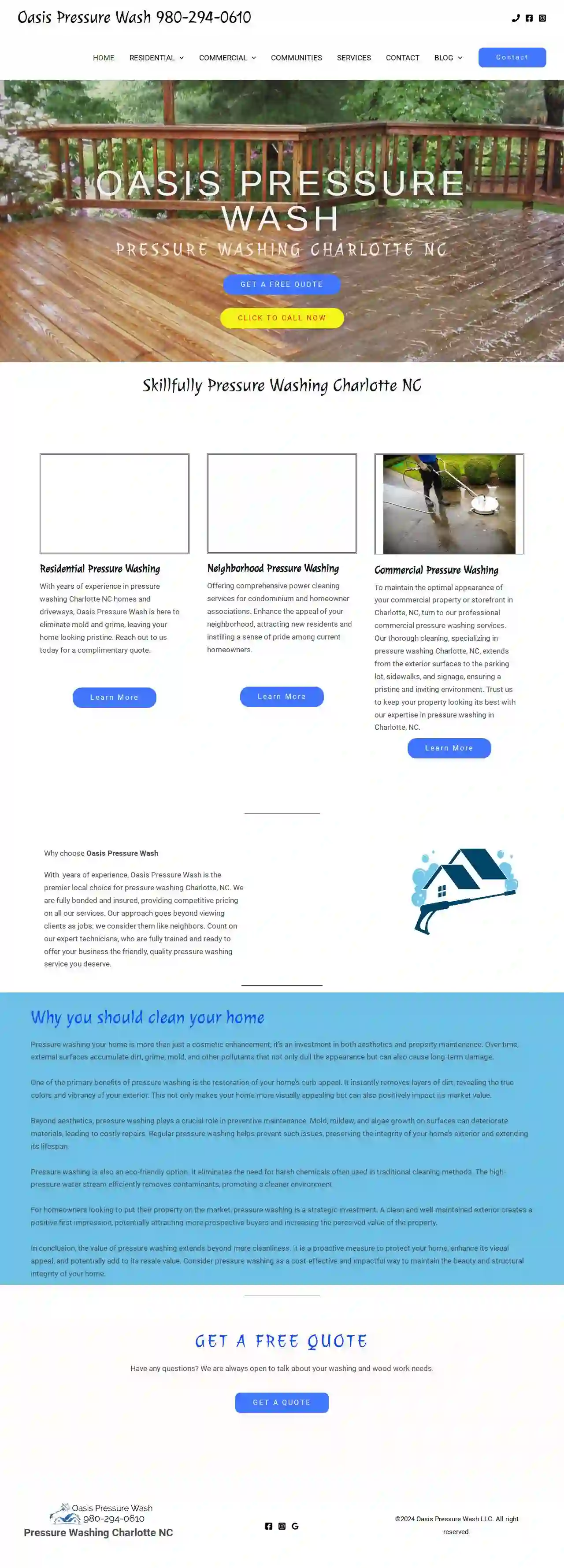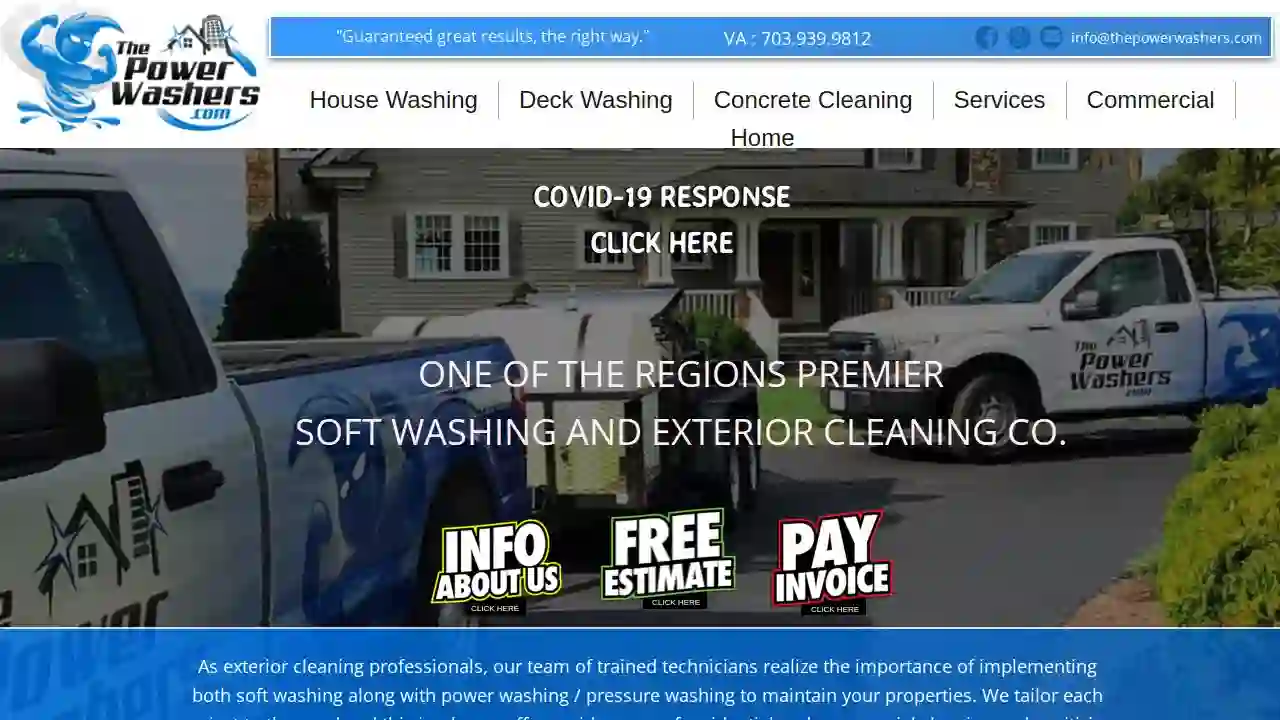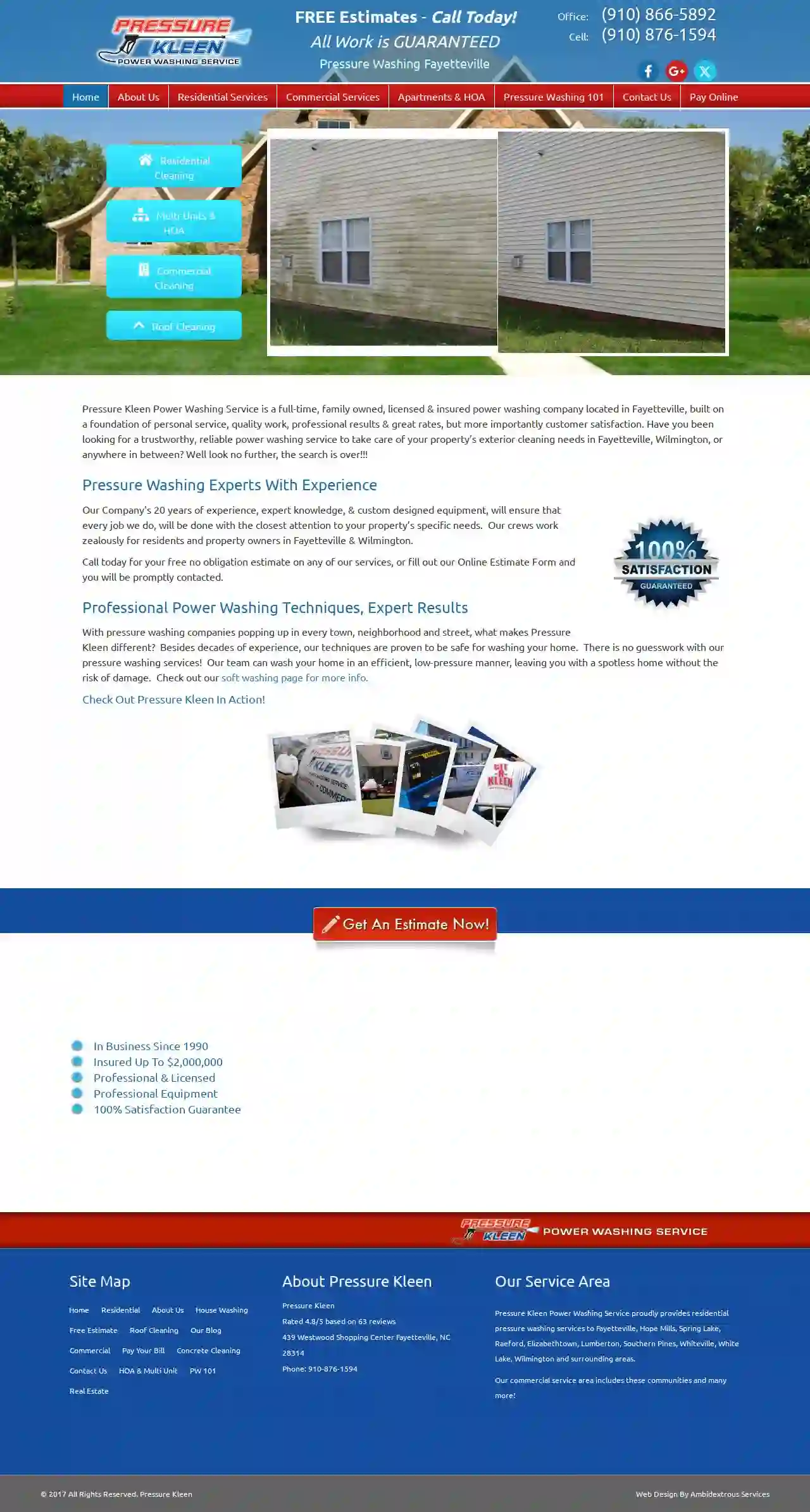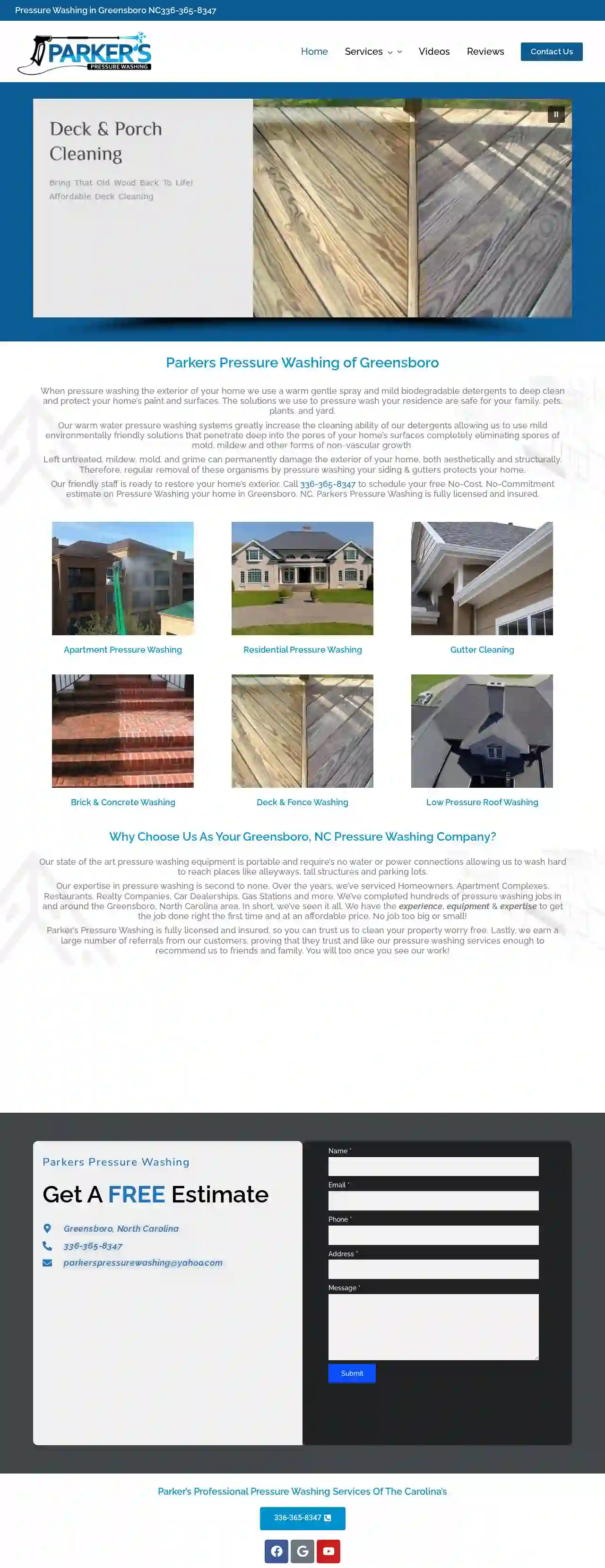Pressure Washing Clayton
Best Power Washing in Clayton
Get up to 3 Power Washing quotes for your project today! Compare profiles, reviews, accreditations, portfolio, etc... and choose the best offer.

WNC Wash Pro's
4.9215 Oak Terrace Rd, Suite I, Asheville, 28806, USWNC Wash Pros is a leading provider of professional pressure washing and soft washing services in Asheville, NC and surrounding areas. We are committed to delivering exceptional results for both residential and commercial clients. With over 3000 jobs completed annually, our team of experienced professionals has the knowledge and expertise to handle any cleaning challenge. We offer a wide range of services, including house washing, roof cleaning, deck and fence cleaning, concrete and driveway cleaning, graffiti removal, and more. We use only the highest quality equipment and environmentally friendly cleaning solutions to ensure a safe and effective clean. At WNC Wash Pros, we pride ourselves on our attention to detail, customer satisfaction, and competitive pricing. Contact us today for a free estimate and let us help you restore the beauty and value of your property.
- Services
- Why Us?
- Gallery
Get Quote
Oasis Pressure Wash
Charlotte, NC, 123 Main St, 980-294-0610, USOasis Pressure Wash is a local business that specializes in pressure washing Charlotte NC homes and driveways. With years of experience, we offer comprehensive power cleaning services for residential, commercial, and condominium properties. Our approach goes beyond viewing clients as jobs; we consider them like neighbors. Count on our expert technicians, who are fully trained and ready to offer your business the friendly, quality pressure washing service you deserve. Pressure washing your home is more than just a cosmetic enhancement; it’s an investment in both aesthetics and property maintenance. Over time, external surfaces accumulate dirt, grime, mold, and other pollutants that not only dull the appearance but can also cause long-term damage. One of the primary benefits of pressure washing is the restoration of your home’s curb appeal. It instantly removes layers of dirt, revealing the true colors and vibrancy of your exterior. This not only makes your home more visually appealing but can also positively impact its market value. Beyond aesthetics, pressure washing plays a crucial role in preventive maintenance. Mold, mildew, and algae growth on surfaces can deteriorate materials, leading to costly repairs. Regular pressure washing helps prevent such issues, preserving the integrity of your home’s exterior and extending its lifespan. Pressure washing is also an eco-friendly option. It eliminates the need for harsh chemicals and reduces the risk of environmental damage.
- Services
- Why Us?
- Gallery
Get Quote
Clear View Window Cleaning And Pressure Washing
4.995 reviews123 Main St, Kennewick, 99301, USClear View Window Cleaning and Pressure Washing is a professional window washing and pressure washing service provider based in Washington. With over 10 years of experience, they offer a range of services including exterior and interior window washing, hard water removal, gutter cleaning, and pressure washing. They serve residential and commercial customers in Kennewick, Richland, West Richland, Pasco, Benton City, Walla Walla, Prosser, Benton County, Franklin County, and Walla Walla County. Their team of professional technicians is dedicated to providing excellent customer service, ensuring that every job is completed to the highest standard. With a 100% satisfaction guarantee, Clear View Window Cleaning and Pressure Washing is the perfect choice for all your window cleaning and pressure washing needs.
- Services
- Why Us?
- Accreditations
- Our Team
- Testimonials
- Gallery
Get Quote
Precision Pro Wash of WNC
5191 reviews123 Main St, Asheville, 28803, USAward Winning Cleaning! With Precision, we guarantee your complete satisfaction! Over 700 5-Star Reviews. Choose the one that’s TRUSTED. Pressure washing isn’t as simple as it may seem. One needs to have vast knowledge and experience in providing this essential service. Over the years, Precision Pro Wash has grown to be the primary source of pressure washing education and training throughout the US. We are a nationally-recognized exterior cleaning company that specializes in pressure washing, soft washing, gutter cleaning, and commercial power washing services. Our primary goal is to give every customer an exceptional “cleaning experience” from beginning to end and years beyond that. We know that trust and reputation matter to you. It is everything for us service companies, too. Hence, your genuine satisfaction is equally important as how clean and fresh we leave your valuable property. Come and see what our customers are saying. Be The Next Raving Fan! Your experience matters. If you care about the exterior surfaces of your home, you owe it to yourself to call Precision Pro Wash.
- Services
- Why Us?
- Gallery
Get Quote
The Power Washers of Charlotte
54 reviews105 Executive Drive #230, Sterling, 20166, USThe Power Washers is one of the region's premier soft washing and exterior cleaning companies. We offer a wide range of residential and commercial cleaning and sanitizing services that can restore the original look of your property and help you keep it shining for years to come. Our team of trained technicians realizes the importance of implementing both soft washing and power washing/pressure washing to maintain your properties. We tailor each project to the need and offer a free estimate. We serve various areas including Aldie, Alexandria, Annandale, Arlington, Ashburn, Bristow, Brambleton, Bealeton, Braemar, Burke, Centreville, Clifton, Chantilly, Dale City, Dulles, Dumfries, Fairfax, Fairfax Station, Falls Church, Fredericksburg, Gainesville, Great Falls, Haymarket, Herndon, Leesburg, Lansdowne, Lake Ridge, Lorton, Manassas, McLean, Middleburg, Montclair, Nokesville, Oakton, Potomac Falls, Reston, South Riding, Springfield, Stafford, Sterling, Tysons, Vienna, Warrenton, and Woodbridge.
- Services
- Why Us?
- Gallery
Get Quote
Blast Exterior Cleaning
542 reviewsHendersonville, USBlast Exterior Cleaning is a professional power washing company serving Hendersonville, NC and surrounding areas, providing quality services to enhance the appearance of homes and businesses. With a team of highly skilled professionals and state-of-the-art equipment, we offer top-notch exterior cleaning services to ensure homes and businesses look their best and maintain their longevity.
- Services
- Why Us?
- Our Team
- Testimonials
- Gallery
Get Quote
Pressure Kleen Power Washing Service
4.9161 reviewsFayetteville, NC, 439 Westwood Shopping Center, 28314, USPressure Kleen Power Washing Service is a full-time, family owned, licensed & insured power washing company located in Fayetteville, built on a foundation of personal service, quality work, professional results & great rates, but more importantly customer satisfaction. Our Company’s 20 years of experience, expert knowledge, & custom designed equipment, will ensure that every job we do, will be done with the closest attention to your property’s specific needs.
- Services
- Why Us?
- Accreditations
- Our Team
- Testimonials
- Gallery
Get Quote
Tri Cities Powerwashing LLC
54 reviewsApex, USWelcome to Tri Cities Powerwashing! We specialize in restoring color and vibrance to your home, business, and surroundings. Our team of experienced professionals provides a broad range of pressure washing services, including roof washing, hard scape pressure washing, soft washing, window washing, fence cleaning, oil stain removal, and rust removal. We're dedicated to helping you maintain impeccable properties for your residential or commercial space. At Tri Cities Powerwashing, we understand the importance of a clean and well-maintained exterior. That's why we offer a wide range of pressure washing services to meet your specific needs. Whether you need to refresh your home's curb appeal or prepare your commercial property for a new season, we have the expertise and equipment to get the job done right. Our commitment to quality and customer satisfaction is unwavering. We use only the highest quality products and techniques to ensure that your property looks its best. We're also fully insured and licensed, so you can rest assured that you're in good hands. Contact us today for a free quote and let us help you restore the beauty of your property.
- Services
- Why Us?
- Gallery
Get Quote
R&L Professional Cleaning
5100 reviewsHuntersville, NC, 183 Montibello Dr, 28117, USR&L Professional Cleaning is the area's premier name in top-notch pressure washing services for home and business properties alike. We're the trusted source for pressure washing services in Huntersville, providing our clients with the very best in quality exterior cleaning services, using eco-friendly chemicals to protect paint and increase longevity. Our team of skilled pros can handle house washing, roof cleaning, driveway & sidewalk cleaning, gum removal, and more. We serve Charlotte, Mooresville, Huntersville, Denver, Harrisburg, Concord, Newton, Statesville, Lincolnton, and Stanley.
- Services
- Why Us?
- Accreditations
- Our Team
- Testimonials
- Gallery
Get Quote
Parkers Pressure Washing of Greensboro, NC
4.821 reviewsGreensboro, USParkers Pressure Washing of Greensboro When pressure washing the exterior of your home we use a warm gentle spray and mild biodegradable detergents to deep clean and protect your home’s paint and surfaces. The solutions we use to pressure wash your residence are safe for your family, pets, plants, and yard.Our warm water pressure washing systems greatly increase the cleaning ability of our detergents allowing us to use mild environmentally friendly solutions that penetrate deep into the pores of your home’s surfaces completely eliminating spores of mold, mildew and other forms of non-vascular growth.Left untreated, mildew, mold, and grime can permanently damage the exterior of your home, both aesthetically and structurally. Therefore, regular removal of these organisms by pressure washing your siding & gutters protects your home.Our friendly staff is ready to restore your home’s exterior. Call 336-365-8347 to schedule your free No-Cost, No-Commitment estimate on Pressure Washing your home in Greensboro, NC. Parkers Pressure Washing is fully licensed and insured.
- Services
- Why Us?
- Gallery
Get Quote
Over 60,241+ Cleaning Services in our network
Our janitorial contractors operate in Clayton & beyond!
CleaningMatch has curated and vetted the Best Cleaning Services in Clayton. Find a top & trustworthy business today.
Frequently Asked Questions About Pressure Washing
- Cover or Shield Plants: Before pressure washing, cover or shield delicate plants and landscaping with tarps, plastic sheeting, or painter's tape to protect them from water spray and chemicals.
- Use Lower Pressure Settings: If pressure washing near plants, use lower pressure settings and avoid directing the spray directly at them.
- Rinse Plants with Water: After pressure washing, rinse plants thoroughly with plain water to dilute any chemicals that may have landed on them.
- Choose Plant-Safe Cleaning Solutions: If using cleaning solutions, opt for environmentally friendly or plant-safe options whenever possible.
- Pressure Washing: If your siding is in good condition but dirty or stained, pressure washing can effectively restore its appearance without the need for painting.
- Painting: If your siding is faded, chipped, peeling, or damaged, pressure washing alone may not be sufficient. Painting provides a fresh coat of protection and a new look.
- Pressure Washing Before Painting: Pressure washing is an essential step before painting, as it removes dirt, grime, and loose paint, creating a clean surface for the new paint to adhere to.
- Size of the Area: Larger areas generally cost more to pressure wash than smaller ones.
- Type of Surface: Different surfaces require different pressure levels and cleaning solutions, which can affect pricing.
- Condition of the Surface: Heavily soiled or stained surfaces may require more time and effort to clean, impacting cost.
- Accessibility: Difficult-to-reach areas may require specialized equipment and increase costs.
- Additional Services: Services like pre-treating stains, applying protective coatings, or mold removal may incur additional charges.
- Wear Protective Gear: Wear safety glasses, closed-toe shoes, and long pants to protect yourself from flying debris and water spray.
- Never Point the Nozzle at Yourself or Others: High-pressure water can cause serious injuries. Always point the nozzle away from yourself, others, and pets.
- Use Caution on Ladders: If working on a ladder, ensure it is stable and secure. Avoid overreaching or leaning too far to one side.
- Be Mindful of Electrical Hazards: Keep water away from electrical outlets, wiring, and appliances.
- Follow Manufacturer's Instructions: Always read and follow the pressure washer manufacturer's instructions for safe operation and maintenance.
Can pressure washing damage my plants?
Taking these precautions minimizes the risk of damage to your plants and landscaping during pressure washing.
Is it better to pressure wash or paint my house?
Assess the condition of your siding and your desired outcome to determine whether pressure washing, painting, or a combination of both is the best approach.
How much does pressure washing cost?
To get accurate pricing, request quotes from multiple pressure washing companies. Provide details about the size and type of surface, its condition, and any additional services you require.
What are some safety precautions to take when pressure washing?
Prioritizing safety when pressure washing protects you and others from potential injuries or accidents.
Can pressure washing damage my plants?
- Cover or Shield Plants: Before pressure washing, cover or shield delicate plants and landscaping with tarps, plastic sheeting, or painter's tape to protect them from water spray and chemicals.
- Use Lower Pressure Settings: If pressure washing near plants, use lower pressure settings and avoid directing the spray directly at them.
- Rinse Plants with Water: After pressure washing, rinse plants thoroughly with plain water to dilute any chemicals that may have landed on them.
- Choose Plant-Safe Cleaning Solutions: If using cleaning solutions, opt for environmentally friendly or plant-safe options whenever possible.
Taking these precautions minimizes the risk of damage to your plants and landscaping during pressure washing.
Is it better to pressure wash or paint my house?
- Pressure Washing: If your siding is in good condition but dirty or stained, pressure washing can effectively restore its appearance without the need for painting.
- Painting: If your siding is faded, chipped, peeling, or damaged, pressure washing alone may not be sufficient. Painting provides a fresh coat of protection and a new look.
- Pressure Washing Before Painting: Pressure washing is an essential step before painting, as it removes dirt, grime, and loose paint, creating a clean surface for the new paint to adhere to.
Assess the condition of your siding and your desired outcome to determine whether pressure washing, painting, or a combination of both is the best approach.
How much does pressure washing cost?
- Size of the Area: Larger areas generally cost more to pressure wash than smaller ones.
- Type of Surface: Different surfaces require different pressure levels and cleaning solutions, which can affect pricing.
- Condition of the Surface: Heavily soiled or stained surfaces may require more time and effort to clean, impacting cost.
- Accessibility: Difficult-to-reach areas may require specialized equipment and increase costs.
- Additional Services: Services like pre-treating stains, applying protective coatings, or mold removal may incur additional charges.
To get accurate pricing, request quotes from multiple pressure washing companies. Provide details about the size and type of surface, its condition, and any additional services you require.
What are some safety precautions to take when pressure washing?
- Wear Protective Gear: Wear safety glasses, closed-toe shoes, and long pants to protect yourself from flying debris and water spray.
- Never Point the Nozzle at Yourself or Others: High-pressure water can cause serious injuries. Always point the nozzle away from yourself, others, and pets.
- Use Caution on Ladders: If working on a ladder, ensure it is stable and secure. Avoid overreaching or leaning too far to one side.
- Be Mindful of Electrical Hazards: Keep water away from electrical outlets, wiring, and appliances.
- Follow Manufacturer's Instructions: Always read and follow the pressure washer manufacturer's instructions for safe operation and maintenance.
Prioritizing safety when pressure washing protects you and others from potential injuries or accidents.